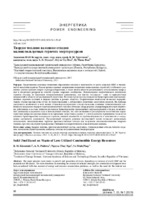| dc.contributor.author | Хрусталев, Б. М. | |
| dc.contributor.author | Пехота, А. Н. | |
| dc.contributor.author | Нгуен, Тху Нга | |
| dc.contributor.author | Ву, Минь Фап | |
| dc.coverage.spatial | Минск | ru |
| dc.date.accessioned | 2021-02-04T10:39:15Z | |
| dc.date.available | 2021-02-04T10:39:15Z | |
| dc.date.issued | 2021 | |
| dc.identifier.citation | Твердое топливо на основе отходов малоиспользуемых горючих энергоресурсов = Solid Fuel Based on Waste of Low-Utilized Combustible Energy Resources / Б. М. Хрусталев [и др.] // Наука и техника. – 2021. – № 1. – С. 58-65. | ru |
| dc.identifier.uri | https://rep.bntu.by/handle/data/85591 | |
| dc.description.abstract | Представлены основные тенденции образования отходов в зависимости от роста мирового ВВП и численности населения планеты. Рассмотрены основные направления концепции национальных стратегий устойчивого развития с учетом проблем энерго- и ресурсосбережения, а также необходимости рационального использования природных и вторичных ресурсов во многих странах мирового сообщества. Использование энергетического потенциала горючих отходов, не нашедших технологического применения, для многих государств – одно из приоритетных направлений в области нетрадиционной энергетики. В статье представлена технология брикетирования многокомпонентных горючих составов в твердое топливо в разных областях. Разработанная технология позволяет перерабатывать отходы производства путем их брикетирования с добавлением различных связующих веществ. На примере связующего компонента в виде вязких углеводородсодержащих отходов показаны основные технологические особенности получения твердого многокомпонентного топлива. Описано оборудование электрогидравлической обработки, работающее в составе линии подготовки к брикетированию применяемых нефтесодержащих отходов, позволяющее уменьшать содержание серы в используемых отходах, что дает возможность регулировать экологические характеристики выбросов вредных веществ на предельно допустимом уровне. С учетом аспектов применения технологии влажного брикетирования материалов отражено влияние влажности на производительность в зависимости от содержания связующего компонента. Предложенный алгоритм решения поставленной задачи позволяет рационально использовать некондиционные горючие производственные отходы для получения многокомпонентного твердого топлива, при этом на стадии производства учитываются энергетические и экологические аспекты. | ru |
| dc.language.iso | ru | ru |
| dc.publisher | БНТУ | ru |
| dc.title | Твердое топливо на основе отходов малоиспользуемых горючих энергоресурсов | ru |
| dc.title.alternative | Solid Fuel Based on Waste of Low-Utilized Combustible Energy Resources | ru |
| dc.type | Article | ru |
| dc.identifier.doi | 10.21122/2227-1031-2021-20-1-58-65 | |
| local.description.annotation | The paper presents main trends in growth and generation of waste, depending on increase of world GDP and the population of the planet. The main directions in extending the concept of national strategies for sustainable development have been considered with due account of energy and resource conservation problems, as well as the need for the rational use of natural and secondary resources in all countries of the world community. The energy potential use of combustible waste that has not found technological application is considered by many countries as one of the priority areas in the field of unconventional energy. The paper describes the main directions in application of the technology for briquetting multicomponent compositions into solid fuel. The developed production technology makes it possible to process waste products by briquetting them with the addition of various binders, and on the example of a binder component in the form of viscous hydrocarboncontaining waste, the main technological features of obtaining solid multicomponent fuel are presented in the paper. The paper describes the equipment for electrohydraulic treatment, which operates as a part of the preparation line for briquetting of the applied oily waste and that allows to reduce the sulphur content in the waste used, and such approach in general permits to regulate the environmental characteristics of harmful substance emissions at the maximum acceptable level. Taking into account the application aspects of the technology for wet briquetting of materials, the paper reflects the main results of the obtained dependences of humidity on productivity according to the content of the binder component. The proposed algorithm for solving the problem makes it possible to rationally use of substandard combustible industrial waste to obtain a multicomponent solid fuel, while at the production stage, the energy and environmental aspects of the resulting fuel are taken into account with due consideration of the component composition of the fuel. | ru |

